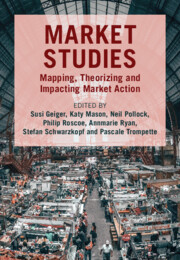Book contents
- Market Studies
- Market Studies
- Copyright page
- Contents
- Figures
- Tables
- Contributors
- Acknowledgements
- Introduction: The Multiple Pasts, Presents and Futures of Markets and Market Studies
- Part I Market Designs and Market Misfires
- Part II Post-Performative Approaches to Studying Markets
- Part III Valuation
- Part IV Markets in Motion: Places and Spaces
- Part V The Secret Life of Market Studies Methods
- Part VI Broadening the Perspectives in Market Studies
- Part VII Future (Im)Perfect Markets
- Index
- References
Part II - Post-Performative Approaches to Studying Markets
Published online by Cambridge University Press: 22 November 2024
- Market Studies
- Market Studies
- Copyright page
- Contents
- Figures
- Tables
- Contributors
- Acknowledgements
- Introduction: The Multiple Pasts, Presents and Futures of Markets and Market Studies
- Part I Market Designs and Market Misfires
- Part II Post-Performative Approaches to Studying Markets
- Part III Valuation
- Part IV Markets in Motion: Places and Spaces
- Part V The Secret Life of Market Studies Methods
- Part VI Broadening the Perspectives in Market Studies
- Part VII Future (Im)Perfect Markets
- Index
- References
- Type
- Chapter
- Information
- Market StudiesMapping, Theorizing and Impacting Market Action, pp. 97 - 160Publisher: Cambridge University PressPrint publication year: 2024

